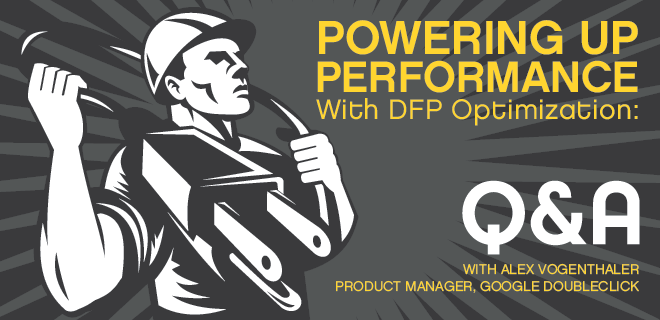
Yesterday at the AdMonsters Publisher Forum in Palm Springs, Google gave us a peek into DoubleClick for Publishers (DFP) Optimization, new technology to “supercharge” the value of both premium and non-premium inventory. We caught up with Alex Vogenthaler, Senior Product Manager, to see how DFP’s new solution differentiates itself and how publisher ad ops expectations are evolving.
What ad op pain points is Google aiming to relieve with DFP Optimization? When implementing the technology, what’s the first thing the ad ops team is likely to notice?
Ad ops will often hear from their Sales team that if they could improve the overall performance of an advertiser’s ads (in terms of clickthrough-rate or conversion rate), the Sales team could close bigger and better deals. Or an ad ops team might hear that to retain a key advertiser, who is frustrated with site performance, they have to drive better performance. What is ad ops to do though? Typically someone on the team will try tweaking targeting (content, time of day, user lists, etc) to find pockets of traffic that perform well for the campaign. But with the number of possible tweaks (literally in the millions), it’s an impossible job to do manually.
DFP Optimization solves this problem by 1) automatically segmenting a publisher’s traffic along every possible dimension: all data from ad tags, any user lists, geography, time of day, site section, etc and then 2) performing controlled experiments for every ad to see which segments perform best for it. It does all of this while respecting the existing targeting and schedule for the ads. The result is automatic lift in performance of virtually every ad across the site.
How does DFP Optimization improve on the ad server’s previous optimization technology? What leaps have been made regarding modeling and pattern recognition?
The system is entirely new, built using the exact same machine learning models that power Google’s own AdWords optimization system. This system supports effectively unlimited numbers of segments, and it refreshes itself automatically every night. Any new data coming in on the ad tags and any shifts in traffic patterns are accounted for within 24 hours.
The other major improvement is that contextual data from AdSense is automatically incorporated into the model for every publisher. AdSense crawls millions of sites and classifies them into a category (e.g. “sports cars” or “digital cameras”), and automatically crawls advertiser landing pages, to help determine what is being sold (car insurance or flash memory cards, for example). Using this data, DFP Optimization can automatically pair run-of-site or run-of-section ads up with just the right content, even when publishers’ own CMSs don’t have subject tags on their articles.
What sets apart DFP Optimization from other publisher-side optimization solutions? How does the service leverage other Google technologies?
DFP Optimization is fully integrated with DFP, so the system is ready to use for all of a publisher’s inventory with the flip of a switch. In addition to advanced modeling and pattern recognition, the system is able to leverage Google’s AdWords machine learning and AdSense contextual matching as additional signals to help deliver ads to users who are more likely to respond to them.
Can you go into detail about reporting features such as the control group? How can publishers best use these options to increase ad spend?
Reporting for DFP Optimization is awesome! All of the reports are built right into the UI, so for any ad or slice of inventory a publisher can see what their lift was (increase in clicks or conversions), the number of extra clicks or conversions, the impact on eCPM (for CPC ads), and what percentage of traffic was optimizable. It’s all right there — including charts and graphs.
Your question about the “control group” gets to the heart of how we can produce these reports. We separate the delivery of every ad into a “test” and “control” group, to perform controlled experiments. That allows us to measure the increase in performance and chart it out right in the reporting UI.
Publishers can use these features to show advertiser how their system performs versus a “non-optimized” baseline. The effect is more repeat business, larger deals the next time around, more referrals and fewer make-goods.
Beyond DFP Optimization, how are publisher expectations of their ad servers changing? How is Google addressing these?
I’ll mention two things here:
1) We heard from publishers for years that impression-based pricing for optimization technologies didn’t line up with their expectations. Publishers who want to use optimization really want to use it on all of their inventory. With the new version of DFP, because the system is so scalable, we have been able to switch to an all-you-can-eat pricing model for Optimization. Once a given publisher signs up with the service it is on for all of their traffic, 100% of the time.
2) Publishers don’t see mobile and video as separate, experimental projects anymore. And they don’t want to use separate technologies to monetize them. With that in mind, DFP Optimization has been built from the ground up to inherently support mobile and video.
 |
Up to date on the latest happenings in the automated trading space? OPS Markets will bring digital advertising leaders and ops professionals together to discuss and develop best practices for operational excellence in the evolving automated landscape. Register today for OPS Markets, which will be held April 18, 2012, in New York. |